skip to main |
skip to sidebar

“Dimension” is a contemporary and reflective narrative about the Europe project. It describes a number of specific European and near East events since 1973 till present. Through a spectrum of culture, politics, tradition, conflict, hope and endurance, it focuses on the evolution of the new Union Superstate, a time period of reform, development, identity and political direction. It is a visual and written account where citizens are at the heart of stories affecting their lives and future; as recorded in the diary of Daniel T. M. Guerlain, photojournalist and documentary photographer. © All rights reserved.

Trying to eradicate tribalism from the world would be a futile endeavour. But Salome hopes that his readers learn to recognize the common traits they share with people all over the world, and thereby develop tolerance and compassion for other tribes. The biggest and broadest tribe is one to which we all belong, and that’s the human race. Click on image to go to the review page.
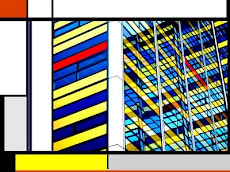
The documentary essay merges with the artistic expression. De Kijk is a tribute to the Dutch masters Theo Van Doesburg, Piet Mondrian who made De Stijl.....the new VVKH building in Leiden. NL

living in the abstract, new photojournalism creates fresh branches for a colourful future
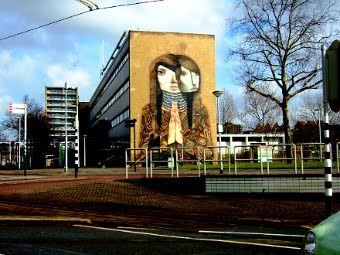
Street propaganda mediums are part of culture wars
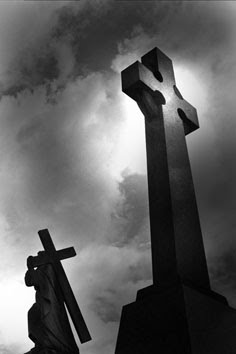
The unsinkable and the infallable show signs of mortality
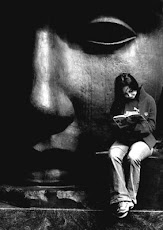
Watching over or just watching. Selection of images from the project , war & the plastik heaven. The Hague, netherlands, a europe burdened with security, 90% of the planets defense budget spent by US & Europe.
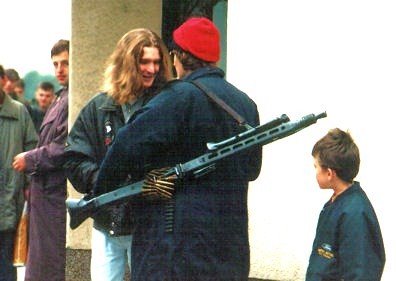
A selection of portraits from the Combatant's project, above, Sarajevo, opposite page, Kurdistan, Iraq, Ulster, Syria, Palestine, Bosnia, Trans-dinistra.

defending Sarajevo 1992

A child slides in Herastrau Park Bucharest 1996
.jpg)
Prisoners lives #2 A recent visit to Auschwitz made me think about borders and how they are crossed.

The commander of the notorious Tenth Crusade leaves his post and his people to their fate he created.
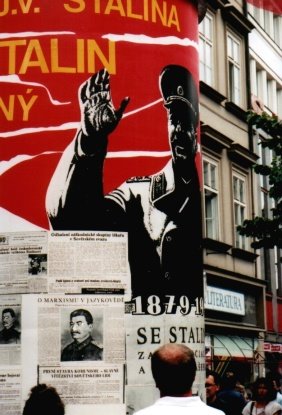
The Christian war machine can produce an array of dubious leaders . The Georgians loved him because he killed so many Russians.............Prague..spring 1990....from War & the Plastik heaven
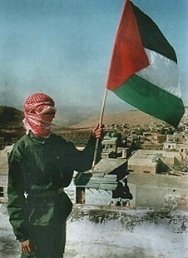
The demographics say it all. From the few thousands to the many millions in only a hundred years, Man triumphs over god's plan for armageddon, or is it just the will to survive.
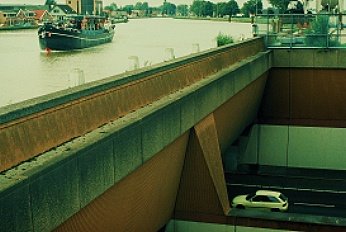
a highway beneath a canal
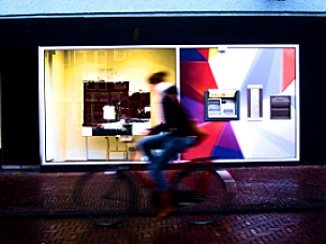
A bank machine next to a Leiden art gallery... july 08........................ Henry Paulson, who cashed out his Goldman stock valued at $575 million to become the Secretary of Treasury (without having to pay any taxes on the sale), earned more than $53 million in pocket change during just his last two years at Goldman Sachs for innovations such as a new line of "Mortgage Backed Securities." Gambling more than a trillion dollars on risky subprime second mortgages......http://www.globalresearch.ca/index.php?context=va&aid=10433........does anybody out there believe in conspiracy theories.
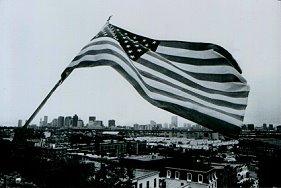
stars & strips over the Boston southie skyline 1988

Mr McCain argued: "We are winning in Iraq and we will come home with victory and with honour,"...and...""Russia has now become a nation fuelled by petro-dollars....I looked in Mr Putin's eyes and I saw three letters - a K, a G and B," whilst Mr Obama pointed "to the spread of al-Qaeda to some 60 countries" and that the US had to do more , including improving its own image as a "beacon of light" on rights." . .......BBC...Saturday, 27 September 2008 08:35 UK ....

This is a little spot on Derry's Walls where girls from a nearby school meet as a private location to discuss things and do things and plan things. It is a long road ahead for these unsuspecting hopefuls.

A picture from Berlin. A Martin Luther King poster I think translates as "Expressing the truth needs courage." Although this was taken in 2006 I feel it can be put to use to celebrate the King anniversay.

"Out of Eden" Devon, England
© A diary on photojournalism & documentary photography. Magazine Photomoderne
Translate to following languages
Additional Content Pages
- Home
- Dimension: Art of Superstate, a Diary by Daniel T. M. Guerlain
- The Citizens Wallpaper Project:La Tene: Apac, associated photojournalism for art and culture
- Apac, associated photojournalism for art and culture; Exhibition Dimension and the Wall Paper Presentation.
- De Tunnel: A Connector between Old and New presentation styles.
- Divided Cities:.Tales from Four Cities
- Review Page: Art, Music, Books and Culture
- Europe's Bright Future: As Good as it Gets
Tales from Four Cities
Subscribe via email
Pageviews
Dimension diary part 1, is Serialised Weekly in Additional Pages. Click on picture

“Dimension” is a contemporary and reflective narrative about the Europe project. It describes a number of specific European and near East events since 1973 till present. Through a spectrum of culture, politics, tradition, conflict, hope and endurance, it focuses on the evolution of the new Union Superstate, a time period of reform, development, identity and political direction. It is a visual and written account where citizens are at the heart of stories affecting their lives and future; as recorded in the diary of Daniel T. M. Guerlain, photojournalist and documentary photographer. © All rights reserved.
Popular Posts
-
This is not a manipulated photograph; it is a reference to Marcel Duchamp and his break with tradition. Like wise, moderne photojournali...
-
(July 15 2010) -- This week a Moscow court rendered a decision that some say could constrain artistic expression throughout Russia fo...
-
In February 1982 Syria’s murderous president, Hafez al-Assad instructed his younger militant brother Rifaat al-Assad to surround the rebelli...
-
In the end, there was never to be any re-construction of the Kingdom of Allah. The troops just left as they always do. After weary unfru...
-
Re-framing reality is a game most dictators and their wives indulge in. It offers solace, a justification for passing their guilt to othe...
-
The EU, launched in January 1993 is a major let down. An organisation bedevilled with controversy and deemed unfit for purpose by governm...
-
It would suit the commission to see the UK bolt for the exit. After all, who wants competition to one’s plan! Using fines and penalti...
-
A chara Sophia Dea-shláinte a thabhairt duit agus an teaghlach How are you in Stockholm this weekend...disappointed after the re...
-
Asking the Kurds to fight IS. A boy from 24 yrs ago pictured as a young resistance fighter against Saddam. Today he faces a greater thr...
-
The Grim reaper returned on Friday 5 th August 2011 almost four years to the day it first appeared to strike its boney knuckle on the door...
Mission
Since it went public in JUNE 2010, the mission of the blog is to promote photojournalism in the photo-moderne context. It welcomes comments and suggestions. The blog will develop its main focus " Dimension, Art of Superstate," towards community citizen's journalism. The project is about Europe, its recent past, present debates and future directions. It will be an exhibition as an informative contemporary and reflective narrative about the most important project challenging Europe since the 1945 Marshall plan. Be part of the " Dimension" story. Engage the community project describing what interests you as a Euro citizen, a media viewer, ...or a citizen journalist.
La Tene
La Tene, the Cooley Gathering
The Review Page: Violence, Veils and Bloodlines

Trying to eradicate tribalism from the world would be a futile endeavour. But Salome hopes that his readers learn to recognize the common traits they share with people all over the world, and thereby develop tolerance and compassion for other tribes. The biggest and broadest tribe is one to which we all belong, and that’s the human race. Click on image to go to the review page.
Post-post photojournalism is now Photomoderne.
Post photojournalism entered the media world around 2003 with the arrival of citizens journalism. There came the use of free Internet images with decline in newspaper readership and revenue. Though it was depleting as a press profession photojournalists refused to abandon it as an outdated medium.
In post-post photojournalism (since 2008) where acceptance of all things new, creation of new roles, markets and the return of the credible source to verify Citizen's news, we see photojournalism branching in many directions. Today it evolves, develops, and creates a powerful destiny to fulfill.
Post-post photojournalism is now Photomoderne breaking with tradition.
In post-post photojournalism (since 2008) where acceptance of all things new, creation of new roles, markets and the return of the credible source to verify Citizen's news, we see photojournalism branching in many directions. Today it evolves, develops, and creates a powerful destiny to fulfill.
Post-post photojournalism is now Photomoderne breaking with tradition.
De Kijk
The documentary essay merges with the artistic expression. De Kijk is a tribute to the Dutch masters Theo Van Doesburg, Piet Mondrian who made De Stijl.....the new VVKH building in Leiden. NL
Trouble with colour
living in the abstract, new photojournalism creates fresh branches for a colourful future
Art and the City

Street propaganda mediums are part of culture wars
Post Religion

The unsinkable and the infallable show signs of mortality
War & the Plastik heaven
Watching over or just watching. Selection of images from the project , war & the plastik heaven. The Hague, netherlands, a europe burdened with security, 90% of the planets defense budget spent by US & Europe.
Combatants

A selection of portraits from the Combatant's project, above, Sarajevo, opposite page, Kurdistan, Iraq, Ulster, Syria, Palestine, Bosnia, Trans-dinistra.

defending Sarajevo 1992
Here we Go ............. BREAKING BORDERS
A child slides in Herastrau Park Bucharest 1996
Borders beyond borders, Crossing the lines
.jpg)
Prisoners lives #2 A recent visit to Auschwitz made me think about borders and how they are crossed.
The Tenth Crusade

The commander of the notorious Tenth Crusade leaves his post and his people to their fate he created.
Onward Christian soldiers
The Christian war machine can produce an array of dubious leaders . The Georgians loved him because he killed so many Russians.............Prague..spring 1990....from War & the Plastik heaven
Where land is Akbar & god is humble
The demographics say it all. From the few thousands to the many millions in only a hundred years, Man triumphs over god's plan for armageddon, or is it just the will to survive.
a highway beneath a canal
The big Run

A bank machine next to a Leiden art gallery... july 08........................ Henry Paulson, who cashed out his Goldman stock valued at $575 million to become the Secretary of Treasury (without having to pay any taxes on the sale), earned more than $53 million in pocket change during just his last two years at Goldman Sachs for innovations such as a new line of "Mortgage Backed Securities." Gambling more than a trillion dollars on risky subprime second mortgages......http://www.globalresearch.ca/index.php?context=va&aid=10433........does anybody out there believe in conspiracy theories.
Let the battle for new Rome commence
stars & strips over the Boston southie skyline 1988
McCain and Obama spar in first debate
Mr McCain argued: "We are winning in Iraq and we will come home with victory and with honour,"...and...""Russia has now become a nation fuelled by petro-dollars....I looked in Mr Putin's eyes and I saw three letters - a K, a G and B," whilst Mr Obama pointed "to the spread of al-Qaeda to some 60 countries" and that the US had to do more , including improving its own image as a "beacon of light" on rights." . .......BBC...Saturday, 27 September 2008 08:35 UK ....
Relationships
This is a little spot on Derry's Walls where girls from a nearby school meet as a private location to discuss things and do things and plan things. It is a long road ahead for these unsuspecting hopefuls.
King anniversary
A picture from Berlin. A Martin Luther King poster I think translates as "Expressing the truth needs courage." Although this was taken in 2006 I feel it can be put to use to celebrate the King anniversay.
EDEN
"Out of Eden" Devon, England
Blog Archive
- 08/18 - 08/25 (1)
- 05/19 - 05/26 (1)
- 01/20 - 01/27 (1)
- 12/09 - 12/16 (1)
- 11/11 - 11/18 (1)
- 05/27 - 06/03 (1)
- 04/01 - 04/08 (1)
- 03/25 - 04/01 (1)
- 10/22 - 10/29 (1)
- 09/24 - 10/01 (1)
- 05/28 - 06/04 (1)
- 04/09 - 04/16 (1)
- 03/26 - 04/02 (1)
- 01/15 - 01/22 (1)
- 12/04 - 12/11 (1)
- 11/13 - 11/20 (1)
- 10/02 - 10/09 (1)
- 09/18 - 09/25 (1)
- 08/21 - 08/28 (1)
- 07/10 - 07/17 (1)
- 06/26 - 07/03 (1)
- 06/19 - 06/26 (1)
- 06/05 - 06/12 (1)
- 05/29 - 06/05 (1)
- 05/01 - 05/08 (1)
- 03/27 - 04/03 (1)
- 02/21 - 02/28 (1)
- 01/31 - 02/07 (1)
- 01/17 - 01/24 (1)
- 10/11 - 10/18 (1)
- 09/20 - 09/27 (1)
- 08/02 - 08/09 (1)
- 07/12 - 07/19 (1)
- 06/14 - 06/21 (1)
- 05/10 - 05/17 (1)
- 03/29 - 04/05 (1)
- 03/01 - 03/08 (1)
- 01/25 - 02/01 (1)
- 12/07 - 12/14 (1)
- 11/09 - 11/16 (1)
- 10/26 - 11/02 (1)
- 10/19 - 10/26 (1)
- 09/21 - 09/28 (1)
- 09/14 - 09/21 (2)
- 09/07 - 09/14 (2)
- 08/03 - 08/10 (1)
- 06/29 - 07/06 (1)
- 06/08 - 06/15 (1)
- 05/25 - 06/01 (2)
- 04/20 - 04/27 (1)
- 04/13 - 04/20 (1)
- 03/16 - 03/23 (1)
- 03/02 - 03/09 (1)
- 02/23 - 03/02 (1)
- 02/16 - 02/23 (1)
- 02/09 - 02/16 (1)
- 01/26 - 02/02 (1)
- 01/05 - 01/12 (1)
- 12/29 - 01/05 (1)
- 12/01 - 12/08 (1)
- 10/13 - 10/20 (1)
- 10/06 - 10/13 (1)
- 09/22 - 09/29 (1)
- 09/15 - 09/22 (1)
- 09/01 - 09/08 (1)
- 07/28 - 08/04 (1)
- 07/07 - 07/14 (1)
- 06/30 - 07/07 (1)
- 06/23 - 06/30 (1)
- 06/09 - 06/16 (1)
- 06/02 - 06/09 (1)
- 05/12 - 05/19 (1)
- 05/05 - 05/12 (1)
- 04/28 - 05/05 (1)
- 04/21 - 04/28 (1)
- 04/14 - 04/21 (2)
- 03/24 - 03/31 (1)
- 03/10 - 03/17 (1)
- 03/03 - 03/10 (1)
- 02/10 - 02/17 (1)
- 01/27 - 02/03 (1)
- 12/23 - 12/30 (1)
- 12/02 - 12/09 (1)
- 11/18 - 11/25 (1)
- 11/11 - 11/18 (2)
- 11/04 - 11/11 (1)
- 10/28 - 11/04 (1)
- 10/14 - 10/21 (1)
- 10/07 - 10/14 (1)
- 09/30 - 10/07 (1)
- 09/09 - 09/16 (2)
- 08/26 - 09/02 (1)
- 08/19 - 08/26 (2)
- 08/12 - 08/19 (1)
- 08/05 - 08/12 (2)
- 07/29 - 08/05 (1)
- 07/22 - 07/29 (3)
- 07/15 - 07/22 (1)
- 07/08 - 07/15 (1)
- 07/01 - 07/08 (1)
- 06/24 - 07/01 (1)
- 06/17 - 06/24 (3)
- 06/10 - 06/17 (1)
- 06/03 - 06/10 (2)
- 05/27 - 06/03 (1)
- 05/13 - 05/20 (1)
- 05/06 - 05/13 (1)
- 04/15 - 04/22 (1)
- 03/18 - 03/25 (1)
- 03/04 - 03/11 (1)
- 02/26 - 03/04 (2)
- 02/19 - 02/26 (2)
- 02/12 - 02/19 (2)
- 02/05 - 02/12 (3)
- 01/29 - 02/05 (1)
- 01/22 - 01/29 (1)
- 01/15 - 01/22 (1)
- 01/08 - 01/15 (1)
- 12/25 - 01/01 (1)
- 12/18 - 12/25 (1)
- 12/11 - 12/18 (2)
- 12/04 - 12/11 (3)
- 11/27 - 12/04 (3)
- 11/20 - 11/27 (2)
- 11/13 - 11/20 (2)
- 11/06 - 11/13 (2)
- 10/30 - 11/06 (2)
- 10/02 - 10/09 (1)
- 09/25 - 10/02 (2)
- 09/18 - 09/25 (2)
- 09/11 - 09/18 (2)
- 09/04 - 09/11 (3)
- 08/28 - 09/04 (1)
- 08/21 - 08/28 (2)
- 08/14 - 08/21 (2)
- 08/07 - 08/14 (6)
- 07/31 - 08/07 (2)
- 07/17 - 07/24 (1)
- 07/03 - 07/10 (2)
- 06/26 - 07/03 (3)
- 06/19 - 06/26 (1)
- 06/12 - 06/19 (2)
- 06/05 - 06/12 (1)
- 05/22 - 05/29 (2)
- 05/15 - 05/22 (2)
- 05/08 - 05/15 (2)
- 05/01 - 05/08 (4)
- 04/24 - 05/01 (1)
- 04/17 - 04/24 (2)
- 04/10 - 04/17 (1)
- 04/03 - 04/10 (1)
- 03/13 - 03/20 (1)
- 03/06 - 03/13 (1)
- 02/27 - 03/06 (2)
- 02/20 - 02/27 (6)
- 02/13 - 02/20 (2)
- 02/06 - 02/13 (2)
- 01/30 - 02/06 (2)
- 01/23 - 01/30 (4)
- 01/16 - 01/23 (5)
- 01/09 - 01/16 (4)
- 01/02 - 01/09 (4)
- 12/26 - 01/02 (1)
- 12/19 - 12/26 (1)
- 12/12 - 12/19 (2)
- 11/14 - 11/21 (2)
- 10/24 - 10/31 (1)
- 10/03 - 10/10 (2)
- 08/29 - 09/05 (1)
- 08/01 - 08/08 (2)
- 07/25 - 08/01 (1)
- 07/18 - 07/25 (1)
- 06/13 - 06/20 (2)
- 06/06 - 06/13 (1)
- 05/30 - 06/06 (1)
- 05/16 - 05/23 (1)
- 04/18 - 04/25 (1)
- 03/28 - 04/04 (1)
- 03/14 - 03/21 (1)
- 02/28 - 03/07 (1)
- 02/14 - 02/21 (1)
- 12/13 - 12/20 (2)
- 11/29 - 12/06 (1)
- 11/22 - 11/29 (1)
- 11/15 - 11/22 (2)
- 11/08 - 11/15 (1)
- 11/01 - 11/08 (4)
- 10/25 - 11/01 (1)
- 10/11 - 10/18 (1)
- 10/04 - 10/11 (1)
- 08/02 - 08/09 (1)
- 07/05 - 07/12 (1)
- 01/11 - 01/18 (1)
- 01/04 - 01/11 (2)
- 12/28 - 01/04 (2)
- 10/26 - 11/02 (1)
- 10/19 - 10/26 (1)
- 10/12 - 10/19 (2)
- 10/05 - 10/12 (2)
- 09/21 - 09/28 (1)
- 09/07 - 09/14 (1)
- 07/27 - 08/03 (1)
- 07/20 - 07/27 (2)
- 07/13 - 07/20 (1)
- 06/29 - 07/06 (1)
- 06/22 - 06/29 (1)
- 06/01 - 06/08 (1)
- 05/25 - 06/01 (1)
- 05/11 - 05/18 (2)
- 05/04 - 05/11 (1)
- 04/20 - 04/27 (2)
- 04/06 - 04/13 (2)
- 03/30 - 04/06 (1)
- 03/16 - 03/23 (2)
- 03/09 - 03/16 (1)
- 03/02 - 03/09 (2)
- 02/03 - 02/10 (1)
- 01/27 - 02/03 (1)
- 01/20 - 01/27 (1)
- 01/06 - 01/13 (1)















